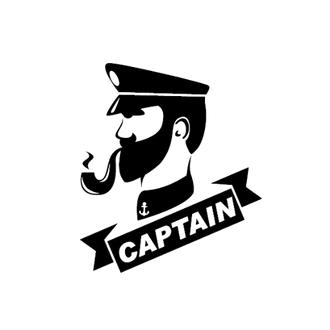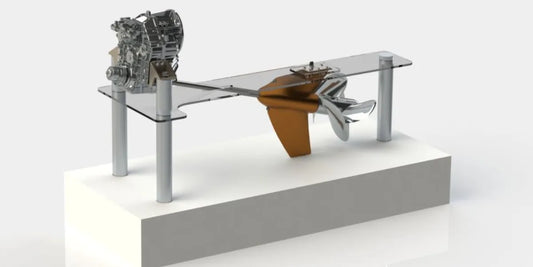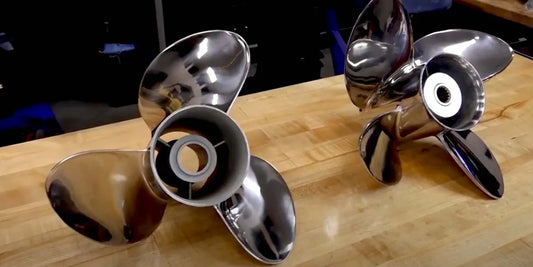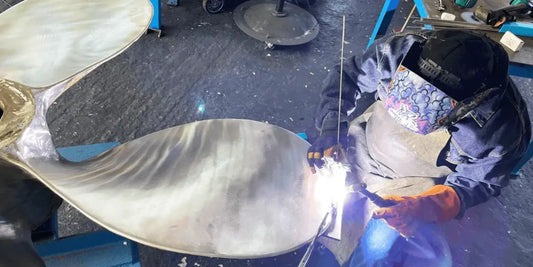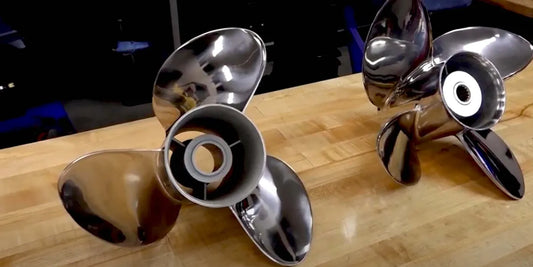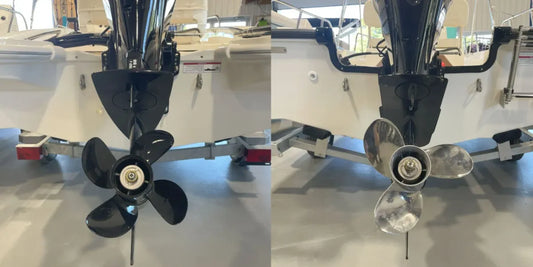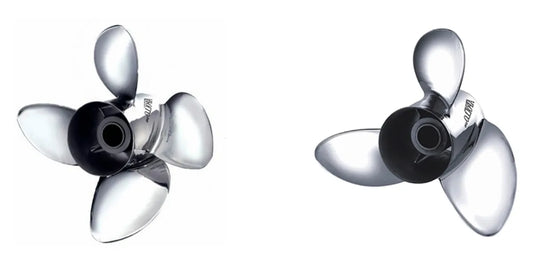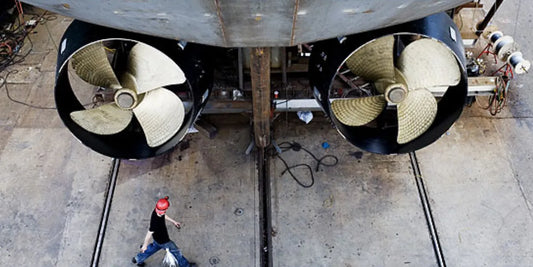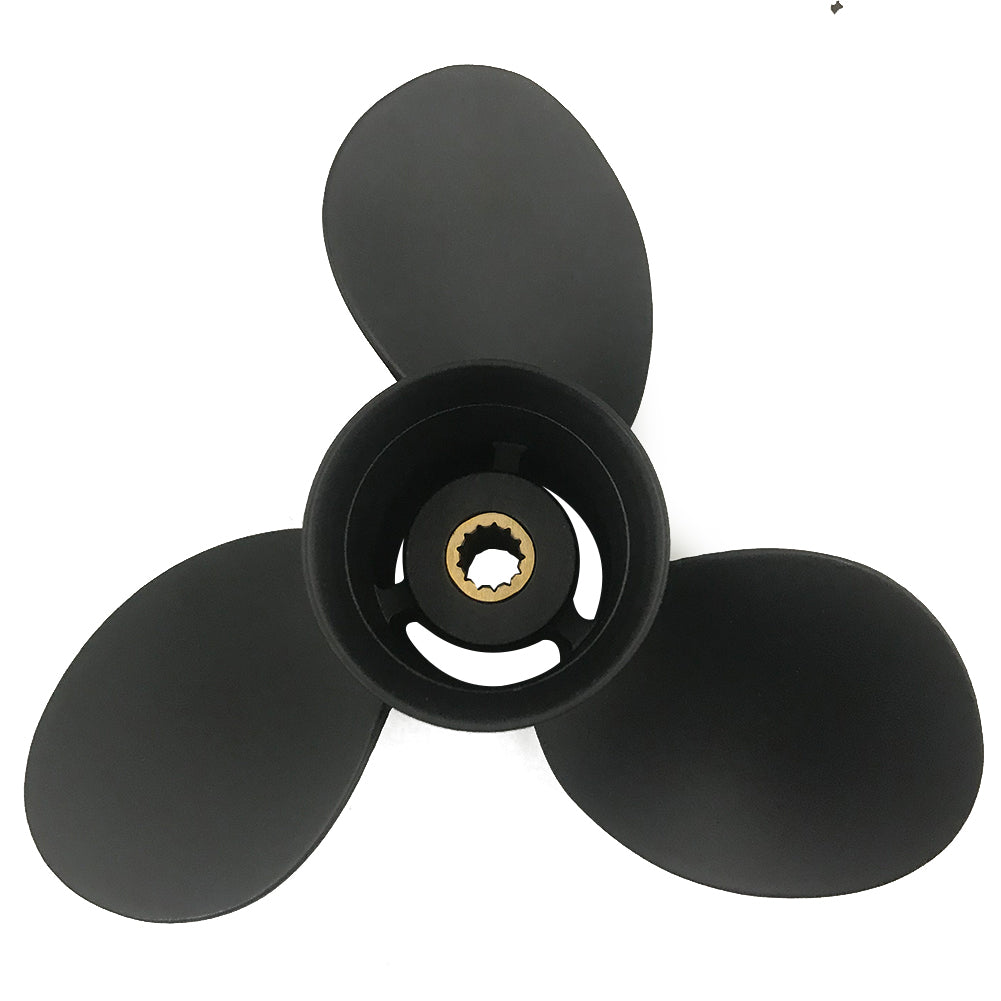Typically, when selecting a propeller for your vessel, the choice often comes down to stainless steel or aluminum. So, how do you opt between the two for your boat? Both options have their pros and cons, which matter in terms of the propeller's working efficiency, and hence it is one of the crucial decisions that will define your boating experience. This article will guide you through the differences between stainless steel and aluminum boat propellers, examining the factors of lifespan and durability, performance, pricing, and usage. An experienced seaman or a weekend boater can consider these attributes to make an informed decision that is compatible with their vessel's requirements and personal boating goals.
Understanding Propeller Types

What is a Stainless Steel Propeller?
A stainless steel propeller is a propeller manufactured from a strong alloy composed primarily of iron, chromium, and additional elements that enhance its strength, corrosion resistance, and performance. Because it offered strength and resistance to wear in the marine environment and reacted with saltwater and other corrosive agents, stainless steel is the preferred choice. These propellers are designed to handle higher torque and stress, making them suitable for boats that require high performance or operate at relatively high speeds.
Stainless steel propellers were introduced for improved efficiency due to the rigid nature of the material, which results in less blade flexing under load compared to aluminum, making acceleration and fuel efficiency paramount. Such propellers find their way on craft where speed is of primary importance, big-weight-carrying boats, or in applications where precision and power are at consideration. Being significantly more expensive compared to aluminum ones and sometimes perhaps costlier to repair if damaged, this trade-off is, however, often justifiable due to the considerable durability and performance it offers under adverse marine conditions.
What is an Aluminum Propeller?
One of the reasons aluminum propellers are popular among boat owners is their affordable cost and versatility. The manufacturing process utilizes a lightweight yet sturdy aluminum alloy that strikes a balance between cost efficiency and reasonably satisfying performance. Aluminum propellers serve well for most casual or recreational boating purposes insofar as they provide sufficient speed and efficiency. Moreover, such propellers are simpler and cheaper to replace or repair compared to stainless steel varieties, which makes it attractive for boaters who are simply tight on cash.
While aluminum is less durable and may deform, bend, or sustain damage more readily when subjected to very high stress or impact, its malleability sometimes reduces the damage sustained by the drive system from severe impact. Additionally, aluminum propellers, being lighter, tend to ease lifting during installation or maintenance. Aluminum propellers, in brief, provide a viable and economical alternative for non-extreme use and are mostly found where moderate load and speed expectations prevail.
Key Differences Between Stainless Steel and Aluminum Propellers
There are a few critical differences when comparing stainless steel and aluminum propellers that highlight their unique performance characteristics and comparative usefulness and cost:
Material Strength and Durability: Stainless steel offers unparalleled strength compared to aluminum. It can withstand a great toque and impact without bending, hence becomes an expected use in high-performance boating applications or when subjected to serious crash conditions underwater. Aluminum, being less rigid and prone to deformation under extreme stress, may absorb minor impacts better and is less likely to cause serious damage to the engine drive system.
Performance Efficiency: Owing to its rigidity, stainless steel propellers offer greater efficiency and precision by maintaining their shape in operation. Acceleration, handling, and fuel efficiency are thereby improved, especially at higher speeds. Aluminum propellers, conversely, have simpler designs and are more apt for medium-speed applications where high performance is not a requirement.
Weight considerations: Aluminum propellers are noticeably lighter, which limits their handling difficulty during installation and maintenance. However, this lighter weight sometimes reduces performance capacity under cumbersome loads or at high speeds compared to the heavier steel type.
Price: Aluminum propellers are significantly cheaper to purchase, making them an attractive option for a casual boater or budget-conscious boat owner. Stainless steel, however, due to its high durability level, has the edge when it comes to long-term value, fewer replacements, and higher performance levels.
Corrosion resistance: Stainless steel propellers have very high corrosion resistance, especially in saltwater, provided correct maintenance is performed on them. Aluminum propellers are also treated for corrosion resistance, but would usually start degrading faster in marine conditions than the stainless steel ones, keeping the latter ones well maintained.
Applications and Usage Scenarios: Stainless steel finds excellent use in high-speed, high-demand, and powerboat, and race-vessel applications. Aluminum propellers are suitable for recreational boats and fishing, as well as for lower to medium demand in use.
Generally, aluminum propellers will offer the best solution from an economic standpoint, while providing adequate performance. Aspiring for more ruggedness, good performance, and value on the long haul, given harsh environments, brings worthy and stainless steel propellers ahead. However, an informed decision will be influenced by your boating requirements and priorities, as well as operational conditions.
Performance Analysis of Stainless Steel Propellers

Advantages of Using Stainless Steel Propellers
These are the propellers that need the name for the strength of stainless steel, which makes them a common choice by the boaters who require high performance. The primary advantage is in increased durability. Stainless steel is far harder than aluminum, which means the propellers will not bend, chip, or warp in marine environments adverse to aluminum or if they hit debris. This durability prolongs the propeller's lifespan and reduces the frequency of replacements.
On the other hand, there's better performance. Being stiff, the stainless steel propeller can possess more sophisticated blade geometry for greater accuracy and less flex during operation. Consequently, acceleration is improved, top speeds are greater, and fuel efficiency is enhanced. In addition, stainless steel propellers often provide more thrust when operating against adverse conditions, such as heavy loads or rough waves, resulting in smooth and reliable boating.
For high-horsepower engine applications, stainless steel is an excellent material that can withstand higher forces and heat, especially when consistent performance is required under demanding working conditions. The downside is that one needs to shell out higher upfront bucks for a stainless steel prop, but the durability and operational efficiency make it worthwhile in the long run.
Performance Benchmark: Speed and Efficiency
In the assessment of speed and efficiency, stainless steel propellers stand out about their attributes. Being a rigid material, less flexing and thrusting occur at higher speeds, facilitating better handling. This results in higher maximum speeds and smoother acceleration, especially when confronted by harsh situations such as agitated waters or heavy loads.
Besides contributing to resistance to efficiently designed waters, stainless steel propellers possess higher drag-reducing capabilities. This theoretically ensures fuel efficiency. Hence, boaters would notice a rise in miles per gallon and a gradual decrease in fuel costs, implying that stainless steel would be an excellent choice for those seeking a balance between performance and operating costs. Together, these factors highlight the importance of having a propeller of excellent quality to achieve optimal speed and efficiency for a reliable and pleasant boat ride.
Case Study: Yamaha Outboard with Stainless Steel Propeller
An example of foregoing adequate material strength or engineering precision for speed is the Yamaha outboard, which features a stainless steel propeller. The Yamaha spirit of innovation finds an excellent sequel in the stainless steel propellers that also boast superior durability and efficiency. One of the remarkable aspects of this combination is the excellent fuel economy it affords, even under very tough conditions, making it the perfect choice for both amateurs and professionals.
Testing throughout varying water conditions—from rough open water and calm inland lakes—has confirmed an increase in thrust and top speed of Yamaha outboards with stainless steel propellers. Based on trial tests compared to traditional aluminum propellers, stainless steel is known to remain intact for long periods while providing smooth acceleration and handling. This comes because it does not flex under pressure and is precisely designed to reduce vibration.
Furthermore, customers report reduced fuel consumption under certain circumstances, by as much as 10%, due to the lowered drag and improved hydrodynamic efficiency characteristic of stainless steel propellers. This performance improvement becomes invaluable during long trips, boosting cost savings while providing a great deal of fun while cruising around.
The Yamaha and stainless steel propeller combination signifies the importance of pairing best-in-class components to fully harness the capabilities of modern outboard engines. Thus, users enjoy the perfect balance of power, reliability, and efficiency for their boating ventures.
Analyzing Aluminum Propeller Performance

Advantages of Aluminum Propellers
Aluminum propellers have several notable advantages, which make them widely used by boat owners and operators for various purposes. One considerable advantage is their price. Aluminum propellers are generally less expensive than those made of stainless steel. Thus, they are beautiful to the budget-conscious boater who would nevertheless like some solid-performance options.
An aluminum propeller must be just light enough to make the entire propulsion system lighter, easier to handle, and more efficient for the engine. Due to this lightness and minimizing engine stress, it leads to smooth acceleration and better mileage.
Another big one is versatility. Aluminum propellers can be manufactured in virtually unlimited styles, ranging from three-blade to four-blade configurations, allowing boaters to choose a specific option based on their need for speed or power. These propellers also perform well in freshwater, provided they are properly maintained, and resist corrosion.
Lastly, aluminum propellers can come as a good option for those just starting out or for those navigating shallower waters. Because it is relatively soft, it can absorb impacts with debris or submerged obstacles just enough to avoid serious damage to the engine's drive system. The high level of affordability, flexibility, and durability makes aluminum propellers a very popular option for boaters seeking to strike a balance between performance and practicality.
Performance Measurement: Acceleration and Handling
Acceleration and handling are two key aspects that significantly influence the boating experience when evaluating propeller performance. The design of the propeller largely determines how fast an object can accelerate from a standing start to cruising speed. Factors such as blade geometry, pitch, and material play a significant role in enabling the propeller to transfer power efficiently from the engine to the water. For example, aluminum propellers are inexpensive, but they may cause less crisp handling due to flexing at high pressure on the side of things, whereas their weight can still provide decent acceleration for casual boating or recreation.
Handling refers to the propeller's ability to act appropriately when performing turns, maneuvers, or when the boat is confronted with rough water conditions. A higher rake angle propeller provides more lift under the bow; more control and stability at higher speeds are gained from that. Also, handling can be influenced by the number of blades; acceleration is quicker and drag is less when using three blades, whereas the four-blade is smoother and handles better but at the cost of marginal top-end speed. By selecting, understanding, or combining factors and conditions, boaters can choose a propeller that provides exactly the balance between acceleration and handling that is suitable for their own needs, whether for leisurely cruising or thrill-filled water sports.
Case study: Mercury Outboard Aluminum Propeller
In reality, one of the advantages that more consumers are going to appreciate is the price-to-performance ratio of the aluminum Mercury outboard propeller. Aluminum propellers have become known for being both light and strong, making them a favored choice for recreational boating and light to moderate horsepower requirements. Testing procedures revealed that the Mercury outboard, paired with a three-blade aluminum propeller, exhibited fast acceleration to planing speed, a crucial feature for civil applications such as tubing and water skiing.
Records from controlled experiments showed a vast advantage in efficiency for this setting. Cruising speed achieved an average fuel consumption reduction of 12 percent compared to a heavier material for a propeller, reinforcing its affordability for common applications. The new propellers are better in the shallows because they can handle minor bumps more effectively than a harder metal prop, thanks to aluminum's softer nature. This consideration is probably important to many recreational boat owners.
The test results further highlighted versatility. In terms of performance capabilities, aluminum props are advantageous because of their easy repairability, making them a preferred choice among small-to-medium recreational boaters who prioritize value and ease of maintenance. It is this blend of efficiency, control, and practicality that has ensured the continued high volume of sales for Mercury outboards with aluminum propellers across a wide range of boats.
Cost Considerations: Stainless Steel vs Aluminum

Price comparison: initial investment and longevity
Initial investment forms a crucial parameter when comparing stainless steel and aluminum propellers. Aluminum propellers are highly affordable, making them a preferred option for buyers with a tight budget or those operating smaller vessels. On the other hand, stainless steel propellers require a relatively high initial cost, two to three times that of aluminum. However, this higher upfront price is offset by the fact that stainless steel, being more durable and having a longer lifespan, is a more cost-effective option in the long term. It resists wear under harsh conditions, such as those with debris or rocky terrain, thus requiring far fewer replacements and incurring lower maintenance costs over time.
Aluminum has a cost-effective appeal when purchased, but after installation, such widespread use would lead to more frequent wear and tear or necessitate repair or replacement, especially in environments that highly promote the chance of impact. The trade-off lies in prioritizing initial cost over later performance. Usually, stainless steel is chosen for high-powered engines, or for those who prefer to eke out maximum efficiency from their boats, it is a worthwhile investment for the longer term.
Maintenance Costs and Durability
When evaluating maintenance costs and durability, the quality of the material and prevailing environmental conditions are key factors. Maintenance of aluminum propellers easily requires frequent inspections and minor repairs. Damage can occur fairly easily through dings and defects if not addressed promptly, ultimately rendering the propeller inefficient or causing further damage. In contrast, stainless steel propellers require less maintenance due to their resilience, but they are more expensive to repair because of the specialized tools and techniques required for their maintenance.
The durability of materials is highly dependent on operating conditions. Stainless steel can perform better over prolonged periods if exposed to erosion in abrasive or debris-filled waters. An industry sentiment that also seemed prevalent was that while stainless steel costs may seem high in terms of initial investments, these investments usually translate into low maintenance costs in the long run, owing to their robustness and hence lower repair costs. The choice should be made by weighing immediate costs against future price and maintenance costs, considering which alternative gives greater value for their money.
Price-Based Customer Preferences
Pricing considerations, preferences, and trends often reveal that affordability lies at the heart of a choice, but seldom does it act as the sole deciding factor. Instead, customers are more concerned with long-term value, such as a balanced consideration of quality, durability, and price, in addition to immediate cost savings. Thus, materials with better performance and lower maintenance costs would be considered a more cost-effective option, notwithstanding their higher upfront cost; for example, stainless steel is considered so in sectors like construction or manufacturing.
Consumers are increasingly seeking transparency in pricing. They expect clear elucidations on the cost and value of higher price tiers. According to the latest industry data, buyers tend to prioritize factors such as extended warranties, environmental sustainability, and improved product lifecycle performance. This indicates a rise in demand for options that offer a fair price and real benefits with lasting effects.
Choosing the Right Propeller for Your Boat

Factors to be Considered While Selecting a Propeller
Some of the critical factors considered for the performance, efficiency, and durability of a particular propeller suitable for choosing his or her boat include the following parameters:
Propeller Material: The choice of propeller material — aluminum, stainless steel, or composite — may affect performance and maintenance considerations. Aluminum propellers weigh less, cost less, and are thus an excellent choice for recreational boats. Stainless steel offers greater strength and durability for high-performance applications. Composite propellers, which are somewhat less common, are popular with designers for their corrosion-resistant and lightweight qualities.
Diameter and Pitch: Pressing harder on water creates thrust. The greater the pressure, the higher its thrust will be. Propellers of larger diameter tend to generate more thrust to handle heavy boats; those with smaller diameters are for high speed. Pitch is the linear distance that a propeller travels through the water in one revolution. Propellers with low pitch are used for towing or heavy loads, and those with high pitch go for speed.
Blade Count and Shape: Propellers generally consist of three or four blades. The three-blade offer higher speeds and are used for most general purposes, while the four-blades render stability, thrust, and fuel efficiency, particularly while cruising or in choppy waters. Moreover, the blades have their variations in shape; certain cupped or swept-back designs are used for ideal adjustments in specific conditions, such as eliminating cavitation or improving cornering.
Boat Type and Aims: The type of boat and its use directly affect the choice of propeller. Sporting craft will want pitches and blade designs that are tailored for maximum speed, while fishing boats look for efficiency in handling loads. It will also be important for flat-bottom vessels or those operating in shallow areas to have propellers in their design that perform well and pose no damage to the working conditions.
Engine Specifications: Consider how a propeller goes along with an engine's horsepower, RPM range, and gear ratio. Compatibility-a mismatch-will endanger accurate operation of the propeller, either straining the engine or causing it to over-rev. If possible, check the recommended guidelines for your engine to check that the propeller is working at the necessary parameter.
Fuel Efficiency and Performance: High-performance propellers lessen wear and improve hull drag for long-term fuel cost savings. Features such as cupped blades or progressively pitched methods promote the smooth operation of the propeller, resulting in better fuel economy, making them a preferable option for frequent boats.
Environmental Conditions: The waters you'll be working in will influence the kind of propeller you choose. Different considerations have to be taken into account for fresh and salt waters, calm lakes, or violent seas. Saltwater applications require the use of corrosion-resistant materials, while shallow water operations necessitate a propeller that can operate near the surface without damaging itself or losing thrust.
Hence, these considerations will help you select a propeller that not only brings out the best in your boat but also best suits your own needs and the conditions set for operation. With this consideration in the pipeline for purchase, smoother-running, better-performing, and cost-efficient journeys are assured in the long run.
Close Recommendations for Boat Owners
I would say the very best advice anyone could give me is to really pay attention to your water environment and usage when choosing equipment, like a propeller. This essentially entails considering the type of water you typically sail through; for instance, is it shallow or salty? And whether the boat will be used for fishing, water sports, or slow cruising. Determining these parameters will enable one to select a propeller that matches their specific operational needs, thereby augmenting its performance and reliability.
Being proactive in maintenance and inspections further increases the life-to-service factor for equipment. Checking for wear and tear on the propeller may help avoid thrust reduction or inefficiency problems. Maintenance, combined with cleaning in saltwater environments, helps prevent corrosion, thereby maintaining peak performance over time. The benefits of maintenance include saving costs on repairs and ensuring a safe and enjoyable experience on a boat.
For the final piece of advice, consider seeking professional marine recommendations for custom guiding services on upgrades or repairs to an existing rig. In this manner, informed choices can be made to fully utilize the boat while avoiding unnecessary aggravations and financial strains.
Future Trends in Propeller Technology
Sensoring phenomena related to the future of propellers may, in the mind, form ideas about the technological uprising, along with its efficiency and sustainability. Some modern trends are rapidly developing toward the widespread use of composite materials in propeller manufacturing. These materials are lighter, corrosion-resistant, and are much more compatible with advanced design than traditional metals. This change also means improved property, durability, and significantly increased fuel efficiency—a statement that ties in very well with the current emphasis on green maritime practices.
The integration of smart technologies in propeller systems is indeed an exciting frontier. Picture a propeller equipped with sensors that monitor its performance in real-time, transmitting data on its speed, vibrations, and energy efficiency. Such an innovation would go a long way in identifying inefficiencies, scheduling maintenance beforehand, and optimizing performance during operation-a real boon for recreational boaters and commercial operators alike, as it cuts down on downtime without compromising the life expectancy.
To me, the unignorable role of automation and AI in the future of propeller technology is a negative aspect. Propeller systems equipped with higher levels of automation would be able to dynamically adjust propeller configurations in response to external environmental changes, such as currents in the water or load conditions, to maintain optimal performance. With AI in design, these developments would give rise to smarter propulsion systems with fine-tuned customizations to meet the individual's needs. Clearly, from my point of view, the future of propeller technology is geared towards making it smart, green, and user-oriented.
Reference Sources
-
Aluminum vs Stainless Steel Prop Blog | Michigan Wheel
Discusses the differences in blade thickness, drag, and performance between aluminum and stainless steel propellers. -
Prop Bites: How To Choose Between Aluminum and Stainless Steel Props | Mercury Marine
Highlights the stress tolerance and performance benefits of stainless steel over aluminum. -
How to Find the Right Boat Propeller | West Marine
Explores the pros and cons of different propeller materials, including aluminum and stainless steel. -
Materials for Marine Propellers and the Differences | PropTech
Compares aluminum and stainless steel propellers for various boating needs, from leisure to high-performance. -
Propeller Basics and How They Affect Boat Performance | Sierra Parts
Provides insights into how material choice impacts propeller performance and suitability for different boats.
Frequently Asked Questions (FAQs)
Advantages of using a stainless steel propeller for my boat
Stainless steel boat propellers offer better durability and efficiency than their aluminum counterparts. Designed to withstand the rigors of marine environments, these propellers deliver improved performance and enhanced fuel economy. Their stiffness also allows for a greater pitch, which contributes to more speed and control. Moreover, the sleek design reduces drag, which boosts the performance of your boat. Most manufacturers offer stainless steel outboards that are custom-made to fit different engine configurations. With a stainless steel propeller, you ensure your boat has low maintenance costs while maintaining high performance over time.
How much are stainless steel boat propellers?
The prices of stainless steel propellers for boats can vary widely, due to variations in design, size, and manufacturer. Generally, prices for high-quality stainless steel propellers range from $150 to $500 or more. High-performance specialty designs, such as Fury and Enertia, the stainless steel series, are usually costlier due to the advanced engineering and performance features they offer. When considering price, consider the long-term benefits that an efficient and durable prop offers. Additionally, when investing in a reputable brand, you enhance your entire boating experience, as a good brand typically provides excellent customer support and service. Seeking the best price may prove complicated; it would be helpful to consider consulting with an expert for guidance.
How do I choose the right pitch for my stainless steel propeller?
Selecting the right pitch for your stainless steel propeller is a critical decision in order to derive the best performance out of any boat. Pitch, being the measure of the distance a propeller would theoretically travel in one complete revolution, gives rise to a higher pitch that offers higher speed and demands more horsepower, and a lower pitch that provides better acceleration and control. When selecting a pitch, ask for factors such as engine power (hp), average load, and the purpose of use—whether recreational or commercial. A marine expert can help pinpoint the perfect pitch based on your expectations and cross-reference the propeller geometry with your boat design. Alternatively, trial and error with various pitch sizes will also clarify the best working fit.
How does a 4-blade stainless steel propeller differ from a 3 3-blade one?
Installations must cater to specific user needs, imparting some benefits that become applicable in varying boating conditions. A 3-blade propeller typically offers higher top speeds and better fuel economy owing to lesser drag. Conversely, the 4-blade propeller configuration reduces acceleration, enhances handling, especially in rough water, and may be necessary for larger boats or heavier loads. The answer is usually determined by the type of configuration your engine supports and the type of driving experience you desire. In addition, a 4 4-bladeless prop is less vibrationally disturbing, producing a much smoother ride. By evaluating your application and performance expectations, you will be able to determine which is right.
How do I ensure the longevity of my stainless steel boat propeller?
Maintenance and proper care are factors that ensure the "life" of a stainless steel boat propeller. In general, look out for signs of damage, such as dings or corrosion, on the propeller, especially after each outing. This should be followed by cleaning with fresh water to prevent saltwater buildup, which causes rust and degradation. A protective coating can further extend its lifespan by several years. Ensure your propeller installation and balance are correct, as improper setup can lead to accelerated wear. A technician may be able to identify and address any latent problems impacting durability during a service call. Thus, the maximum life of a stainless steel propeller is extended by performing these procedures.
What does a hub-kit do in a stainless steel propeller?
The hub kit constitutes the sterling performance and safety bearer of your stainless steel propeller. It will connect the propeller to the drive shaft of the engine, providing a snug fit. Apt hub configuration would absorb shocks and help reduce vibrations, resulting in a smoother ride overall. Additionally, one can replace this hub kit with another propeller without needing to disassemble the entire assembly, making for easier maintenance. A hub kit must be compatible with the type of propeller and engine you have chosen. Most manufacturers supply hub kits, which come in varied applications, thus assuring the best performance and longevity of your stainless steel propeller.
